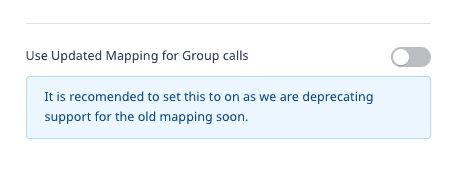RudderStack lets you send your event data to PostHog via the cloud mode.
Identify
You can use RudderStack's identify call to identify a user in PostHog.
A sample identify call is as shown below:
rudderanalytics.identify("1hKOmRA4GRlm", { name: "Alex Keener", first_name: "Alex", last_name: "Keener", email: "alex@example.com", createdAt: "2019-07-23T23:45:56.000Z",})RudderStack passes the user traits within the identify call to PostHog under the $set key according to the PostHog Identify API.
Track
RudderStack's track call lets you capture the user events along with their associated properties and send this data to PostHog.
A sample track call is shown below:
rudderanalytics.track("Order Completed", { checkout_id: "C324532", order_id: "T1230", revenue: 16.98, shipping: 3.0, coupon: "FY21", currency: "INR", products: [ { product_id: "product-mixedfruit-jam", sku: "sku-1", category: "Food", currency: "INR", value: 6.0, typeOfProduct: "Food", url: "https://www.example.com/product/bacon-jam", image_url: "https://www.example.com/product/bacon-jam.jpg", }, ],})PostHog supports the RudderStack track call as type capture. and sends the user action as an event to PostHog according to the PostHog Capture API.
Page
The page call lets you record your app's page views with any additional relevant information about the viewed page.
A sample page call is shown below:
rudderanalytics.page({ path: "/best-seller/1", url: "https://www.estore.com/best-seller/1", title: "EStore Bestsellers", search: "estore bestseller", referrer: "https://www.google.com/search?q=estore+bestseller",})In the above example, RudderStack captures information related to the viewed page such as its path, URL, referrer, etc.
For the page call, RudderStack sends $pageview as an event to PostHog according to the PostHog Page API.
Screen
The screen call lets you record whenever your user views their mobile screen with any additional relevant information about the screen.
A sample screen call using RudderStack's iOS SDK is shown below:
[[RudderClient sharedInstance] screen:@"Home Screen" properties:@{@"category" : @"launcher"}];In the above snippet, RudderStack captures information related to the viewed screen such as its name and category.
For the screen call, RudderStack sends $screen as an event to PostHog according to the PostHog Screen API.
Group
You can use the group call to associate an identified user with a group, such as a company, organization, or an account.
groupId and groupType in your group calls to create or update the group details.A sample group call is shown below:
rudderanalytics.group("group01", { groupType: "Lead", name: "Sample Group", total: 100});name in the group traits, then the group is created in PostHog with that name. Otherwise, it is created by the groupId (if present).For the group call, RudderStack sends $groupidentify as an event to PostHog according to the PostHog Group API.
Updated group mapping
RudderStack lets you use the updated mapping feature for the group calls where it maps the group traits as event properties before sending them to PostHog. To use this feature, enable the Use Updated Mapping for Group calls setting in the RudderStack dashboard, as shown:

By default, the Use Updated Mapping for Group calls setting is disabled in the dashboard. In this case, RudderStack sends the group traits to PostHog as received without any modification, as shown in the following snippet:
{ "version": "1", "type": "REST", "method": "POST", "endpoint": "https://app.posthog.com/batch", "headers": { "Content-Type": "application/json" }, "params": {}, "body": { "JSON": { "groupId": "groupId27", "distinct_id": "sampleusrRudder7", "traits": { "groupType": "company", "KEY_3": { "CHILD_KEY_92": "value_95", "CHILD_KEY_102": "value_103" }, "name_trait": "Company", "value_trait": "Company-ABC" }, "messageId": "e5034df0-a404-47b4-a463-76df99934fea", "event": "$group", "api_key": "LNDs0JGdwbknNGolFc4HdoAE", "type": "group" }, },}When Use Updated Mapping for Group calls is enabled in the dashboard, RudderStack sends the group traits as event properties to PostHog, as shown:
{ "version": "1", "type": "REST", "method": "POST", "endpoint": "https://app.posthog.com/batch", "headers": { "Content-Type": "application/json" }, "params": {}, "body": { "JSON": { "distinct_id": "sampleusrRudder7", "messageId": "e5034df0-a404-47b4-a463-76df99934fea", "properties": { "$group_key": "groupId27", "$group_type": "company", "$group_set": { "KEY_3": { "CHILD_KEY_92": "value_95", "CHILD_KEY_102": "value_103" }, "name_trait": "Company", "value_trait": "Comapny-ABC" }, }, "event": "$group", "api_key": "LNDs0JGdwbknNGolFc4HdoAE", "type": "group" }, },}The mapping is summarized in the following table:
| RudderStack group trait | Updated group mapping disabled | Updated group mapping enabled |
|---|---|---|
groupId | groupId | $group_key |
groupType | groupType | $group_type |
traits | traits | $group_set |
Alias
Calling alias passes userId and previousId to the PostHog queue.
A sample alias call in RudderStack is as shown:
rudderanalytics.alias("user01", "previous01")In the above example, previous01 gets mapped to distinct id in PostHog, while user01 gets mapped to alias in PostHog.
For the alias call, RudderStack sends $create_alias as an event to PostHog according to PostHog Alias API.
Property mappings
RudderStack also maps the following properties to the PostHog standard contextual properties:
| RudderStack field | PostHog field |
|---|---|
context.os.name | $os |
context.page.url | $current_url |
url | $host |
context.page.path | $pathname |
context.screen.height | $screen_height |
context.screen.width | $screen_width |
context.library.name | $lib |
context.library.version | $lib_version |
originalTimestamp,timestamp | $time |
context.device.id | $device_id |
request_ip,context.ip | $ip |
timestamp,originalTimestamp | $timestamp |
anonymousId | $anon_distinct_id |
userId,anonymousId | distinct_id |
context.screen.density | $screen_density |
context.device.manufacturer | $device_manufacturer |
context.os.version | $os_version |
context.timezone | $timezone |
context.locale | $locale |
context.userAgent | $useragent |
context.app.version | $app_version |
context.device.name | $device_name |
context.network.carrier | $network_carrier |
context.app.name | $app_name |
context.device.model | $device_model |
context.app.namespace | $app_namespace |
context.app.build | $app_build |
properties.viewport_height | $viewport_height |
properties.viewport_width | $viewport_width |
context.page.loaded | $performance_page_loaded |
context.campaign.source | utm_source |
context.campaign.medium | utm_medium |
context.campaign.name | utm_campaign |
context.campaign.content | utm_content |
context.campaign.term | utm_term |
Contact us
For more information on the topics covered on this page, email us or start a conversation in our Slack community.